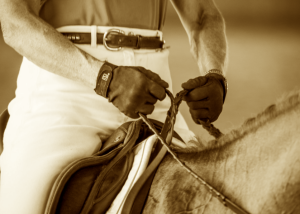Editor’s Note: Best Horse Practices Summit presenter Katrin Silva grew up riding dressage in Germany before moving to the United States at age 19 to learn to ride Western. She’s been riding both disciplines for the last 20 years and is a regular guest columnist for Cayuse Communications. The author of Dressage for All of Us: How to Help Any Horse Become a Happier, More Responsive Riding Partner lives in New Mexico where she works with dressage and Western clients.
Katrin’s upcoming book is Feel for All of Us, due in early 2022. Read more about that here.
 Katrin writes:
Katrin writes:
“My horse has a hard mouth!”
Well-meaning riders use this phrase to justify their need to pull or fiddle on the reins “to get him to soften up,” or to use a more severe bit “because he won’t respect the mild one.”
I’ve seen other, even more well-meaning riders use nothing but a sidepull or a rope halter on their horses, because they fear using a bit “will make his mouth hard.”
All these statements could use reframing.
First, pulling on a horse won’t make his mouth softer. Many years ago, when I worked as an assistant trainer at a Quarter Horse show barn, I spent a lot of time watching the head trainers jerk horses backwards or into small circles. Day after day, week after week, they yanked on their horses, often using twisted-wire bits, gags, or draw reins. When I asked why, they explained that their goal was making the horses soft. Yet the horses never seemed to get the message. Or, they reached a point of not needing such treatment.
 After doing my own share of yanking on the second-string horses I was training, I became convinced that there had to be a better way. I quit the world of western show horses and went back to my dressage roots. But at my next job at a dressage barn, I found myself riding horses who had learned to lean on the bit, so much so that they felt like they’d fall on their noses if I ever let go of the reins. See-sawing with my hands did not make them lighter, it only made their heads wag from side to side.
After doing my own share of yanking on the second-string horses I was training, I became convinced that there had to be a better way. I quit the world of western show horses and went back to my dressage roots. But at my next job at a dressage barn, I found myself riding horses who had learned to lean on the bit, so much so that they felt like they’d fall on their noses if I ever let go of the reins. See-sawing with my hands did not make them lighter, it only made their heads wag from side to side.
I learned something useful from these experiences: a soft mouth does not come from pulling, jerking, or see-sawing on the reins, or from severe bits.
Nor does a soft mouth come from riding without a bit. I know people start young horses in rope halters or use bitless bridles for their horses’ entire riding career. There is nothing inherently wrong it. Any well-trained horse should be able to steer and stop in a halter. But riding bitless is not automatically kinder or more comfortable to the horse. A horse’s face is a very sensitive area, with thin skin that a bitless bridle can easily rub raw. Hackamores, bitless bridles, or rope halters are communication tools, just like headstalls with bits. And just like bits, riders use them correctly and incorrectly. There are valid reasons to go bitless, like an injury to the horse’s mouth, but it’s not a one-size-fits-all solution.
 If you are using a bit, and using it correctly, the horse’s mouth can and will become softer over time, not harder.
If you are using a bit, and using it correctly, the horse’s mouth can and will become softer over time, not harder.
So, what makes for a soft mouth? Two things:
First, a soft mouth is a trusting mouth. A horse can’t be soft if the rider’s hands, or the bit itself, causes discomfort (see above). Trust is earned. The first phase of contact I teach a horse is therefore the kind that follows his mouth, wherever it goes. At this state, the horse’s outline is not important. If he wants to carry his head lower, my reins will be longer. If he wants to carry his head higher, my reins will be shorter. Over time, the balance shifts toward the horse doing what I suggest, which is carry himself in a higher frame when I half-halt, shorten the reins, and then stretch down when I make them longer. But until I’ve earned this privilege, I follow him, not the other way around.
 Second, a soft mouth is an educated mouth. Light contact with the horse’s mouth is like an old-fashioned telegraph wire: information travels back and forth, from horse to rider and vice versa. When both parties understand the signals they are sending each other, their conversation becomes meaningful and pleasant. The tone is respectful and the volume is low. True softness is just that: an ongoing dialogue between the horse’s trusting mouth and the rider’s respectful hands.
Second, a soft mouth is an educated mouth. Light contact with the horse’s mouth is like an old-fashioned telegraph wire: information travels back and forth, from horse to rider and vice versa. When both parties understand the signals they are sending each other, their conversation becomes meaningful and pleasant. The tone is respectful and the volume is low. True softness is just that: an ongoing dialogue between the horse’s trusting mouth and the rider’s respectful hands.